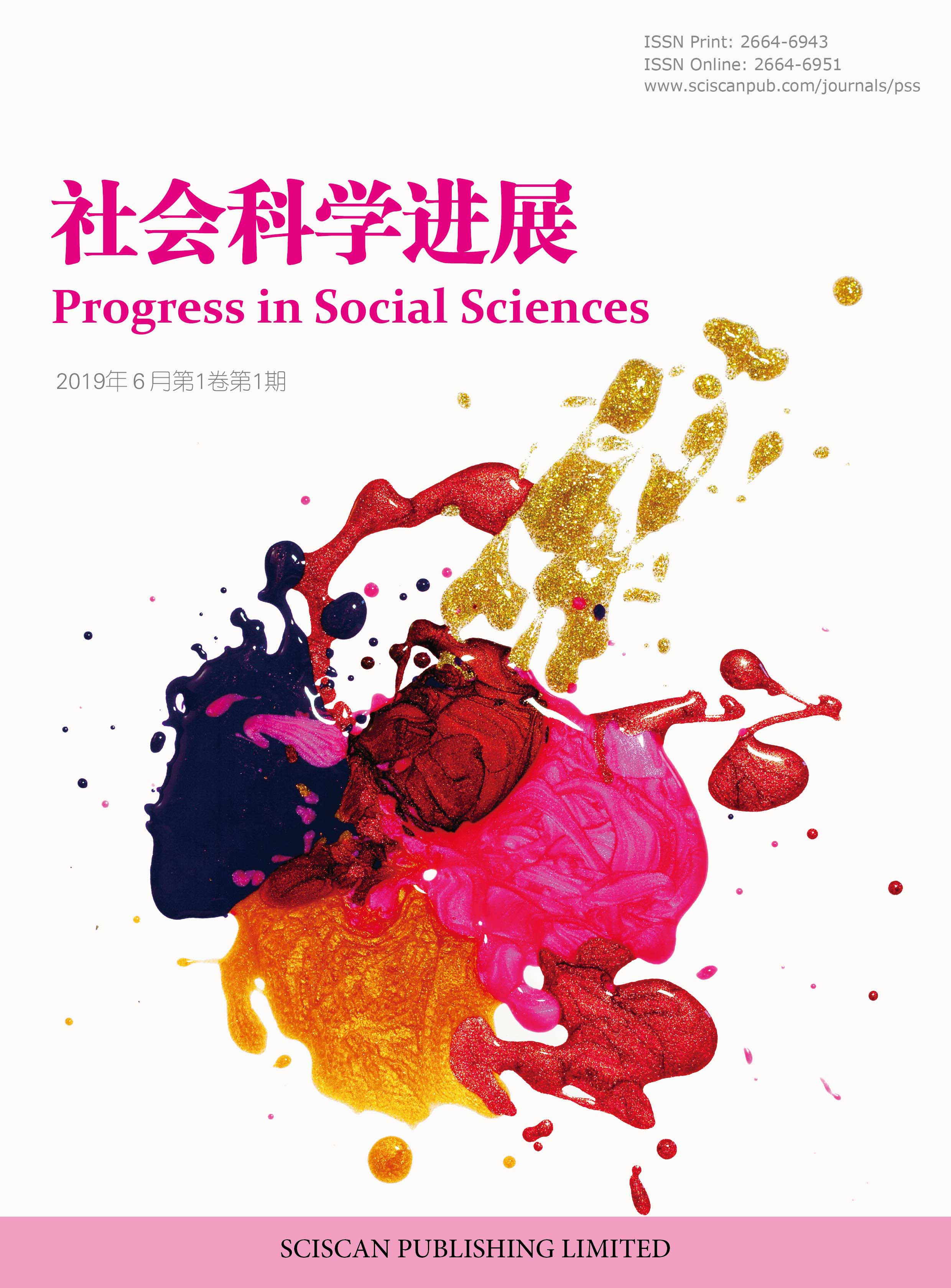Progress in Social Sciences
浅析非遗草编推动乡村振兴的具体路径——以张家口市万全区为例
A Brief Analysis of Specific Paths to Promote Rural Vitalization through Intangible Cultural Heritage Grass Weaving —A Case Study of Wanquan District, Zhangjiakou City
- Authors: 黄雨欣 秦宇卓 程羽漩 陈惠刚
-
Information:
张家口学院,张家口
-
Keywords:
Grass weaving; Rural vitalization; Intangible cultural heritage草编; 乡村振兴; 非物质文化遗产
- Abstract: The craft of straw weaving has a history of 7,000 years, with the earliest known straw artifacts made by the Hemudu people, reflecting a rich cultural heritage and deep cultural accumulation. Zhangjiakou, as a city with a long history, also has this intangible cultural heritage of straw weaving. This article first discusses the development status of straw weaving and its value for inheritance. It then addresses the existing issues in the transmission of straw weaving and proposes solutions. Finally, it explores specific pathways for promoting rural revitalization through intangible cultural heritage straw weaving in the Wanquan District of Zhangjiakou City. 草编迄今已有7000年的历史,已知最早的草编遗物是河姆渡人制作的,具有深厚的文化底蕴和文化积淀,张家口作为一座历史悠久的城市,也拥有草编这一非物质文化遗产。本文首先阐述草编的发展状况及其传承价值,其次针对草编传承现存问题提出解决方案,并立足张家口市万全区,探讨非遗草编推动乡村振兴的具体路径。
- DOI: https://doi.org/10.35534/pss.0702028
- Cite: 黄雨欣,秦宇卓,程羽漩,等.浅析非遗草编推动乡村振兴的具体路径——以张家口市万全区为例[J].社会科学进展,2025,7(2):164-167.

十九大报告强调,必须始终把解决好“三农”问题作为全党工作的重中之重,实施乡村振兴战略。推进乡村全面振兴是新时期新征程上“三农”工作的总抓手。在乡村振兴这条道路上,非遗传承不可或缺,非遗传承为乡村振兴赋能。草编作为一项有着浓厚乡土情怀的非遗,为如何推进乡村振兴提供了一个恰当的切入点。
1 草编的国内外发展现状
1.1 国外发展现状
国外学者虽然没有对草编做过深入研究,但草编在国外有着很广泛的传播和应用。例如非洲、尼泊尔都有当地特色的草编技艺。非洲主要以拉菲草或者棕榈叶为原料,尼泊尔则是利用荨麻和羊毛制作草编制品,两者都具有独特的风格。笔者通过查阅资料发现,日本手工艺者善于将传统工艺与现代工艺相结合、与现代设计相结合,以及与现代需求相结合。日本民众,尤其是日本女性对草编包情有独钟。草编包以其可爱的造型和轻便等特点赢得了日本女性的欢迎,在一段时间内风靡日本的大街小巷。20世纪70年代以来西方国家如美国、加拿大和欧洲等发达国家在“回到大自然中”风潮的影响下,更加喜欢天然材料制品,这对草编制品的销售产生了积极的影响,我国山东莱州草编很大一部分用于出口。
1.2 国内发展现状
在国内,草编作为一项民间手工艺已经有近7000年的历史,已知最早的草编遗物是河姆渡人制作的。草编这项技艺从古代流传至今,一直被人们使用和传播,足以证明草编技艺的价值,人们利用随手可得的柔韧草本植物制作生活用品如草席、坐垫、草帽、草鞋、篮子等。我国草编覆盖范围广,长江流域和黄河流域都有分布,但大多规模较小,规模较大的只有徐行草编、莱州草编、大名草编。随着社会的发展,草编技艺已经离人们的生活越来越远,甚至已经逐渐不被人们问津。直到2008年草编被收录进第二批国家级非物质文化遗产名录才有了复苏的迹象,但草编技艺面对更加现代化的材料及更加多元化的需求的冲击创新能力缺乏,依然遵循着传统的老路制作一些基本的生活用品,发展前景令人担忧。
张家口草编多以麦秸、玉米、棕树叶为原料。现存的非遗传承人有韩六叶和“王氏草编画”传承人王丽莎。韩六叶自幼随祖父母学习草编,后又师承山东“平邑历史草编”传承人李昕、湖北民间草编艺人陈一等人,吸收南北技法精髓,她的作品主要为草编摆件,造型大多为动物;王丽莎作品主要以玉米皮为原料,将传统技艺与现代元素结合起来,把玉米皮裁剪拼贴成画或制作成胸针、发簪等。
2 草编的传承价值
2.1 承载乡愁的载体
(1)情感的纽带
草编是一项具有浓厚乡土情怀的民间艺术,是连接人们与乡土的纽带。对于远离家乡的游子,草编也许会唤起人们心里对家乡的眷恋和思念;来自田间地头的草木也许会勾起人们深埋内心的乡村生活的记忆;淳朴的造型也许会让人们想起家乡的山山水水、老老少少、点点滴滴;纯熟的技艺也许能带给人们一份缺失已久的归属感,也许能引起人们对自己家乡的自豪感。
(2)地域特色的体现
草编的原料反映了当地的自然环境和气候条件。地域不同原料便不同,黄河流域以河南、河北、山东等地多用麦秸、玉米,长江流域多用野生的黄草、苏草、席草(水毛花)、金丝草、蒲草、龙须草、马蔺草、蒯草、荐草、竹壳、箬壳等。不同的原料展现了不同地区的自然环境、气候条件。
草编的用途体现了当地的民俗传统。例如,浙江开化县每逢中秋便会舞草龙来庆丰收、兆吉祥,祈盼风调雨顺、国泰民安,相传在唐宋时开化县就已经有了用草龙来庆丰收的民俗活动,在开化县舞草龙已经成为一个传统,对于开化县草龙也成了一大特色。
2.2 助力可持续发展
收获时节大量秸秆在田间焚烧成为农村环境保护的瓶颈问题,为改善这一问题,国家鼓励秸秆资源的综合利用。秸秆资源的综合利用对于促进农民增收、环境保护、资源节约,以及农业经济可持续发展意义重大。首先,利用麦草、秸秆进行草编工艺对于减少秸秆焚烧、减少空气污染有着积极意义,“变废为宝”助力资源节约。其次,草编制品都利用纯天然材料,并且这些材料可持续再生,加工过程都为人工加工,不利用机械加工、化工染料和重金属染料,对环境影响较小。
2.3 弘扬中华优秀传统文化
习近平总书记指出:“中华优秀传统文化是我们最深厚的文化软实力,也是中国特色社会主义植根的文化沃土。”中华文明是世界文明史上唯一具有连续性的文明,五千年的连续发展是中华文明的重要特征。草编技术作为一种非物质文化遗产,蕴含着从古至今华夏儿女艰苦朴素、自力更生的精神。其传承对于保护和弘扬地方文化具有重要意义。通过传承草编技术,可以让更多人了解和认识到传统文化的魅力,增强文化自信。例如,在绵阳市,非遗工坊通过开展羌族草编技艺的培训和传承,不仅保护了民族文化,还增进了民族团结。
2.4 推动乡村振兴
(1)促进就业和增收
传承草编技艺,可为农村居民特别是妇女、老年人、残疾人等不能外出务工的群体提供就业机会。例如,如陕西汉中,藤编技艺的传承,带动了周边乡镇留守妇女、孤寡老人200余人就业为劳动能力较弱的群体提供了增收渠道。在山东高青县,发展草编产业,使村民们在农闲之余也能获得收入,生活水平得到显著提高。
(2)推动产业发展
传承和发展草编技艺,能够形成促进农村经济发展的特色产业。例如,新河草编产业,年产值达30亿元,产品畅销世界50多个国家和地区,已发展成为集本土文化与时尚特色于一体的特色产业。发展草编产业还可以带动原料种植、加工、销售、物流等相关产业的发展,形成完整的产业链条。
(3)提升乡村形象
发展草编产业,能够提升村容村貌,提高乡村的知名度和美誉度。例如,姚套村发展草编产业,使村容村貌焕然一新,成为高乡镇美丽乡村的代表。同时,销售草编产品还能为改善基础设施、改善公共服务等方面为农村带来经济效益。
(4)培养人才和创新意识
草编技艺的传承,需要培养新一代传承人,这对乡村人才的培养、创新意识的提升,都有积极的促进作用。如临沂市鼓励带徒传艺,通过遴选非遗项目传承人和手工艺人担任技术导师等方式,培养了一批草编技术人才。同时创新发展草编技术,还可以带来农村发展的新机遇。
综上所述,继承草编技术对于乡村振兴具有多方面的作用,包括促进就业、推动产业发展、传承文化遗产、提升乡村形象,以及培养人才和创新意识等。因此,保护和传承草编技术对于实现乡村振兴战略具有重要意义。
3 草编技艺传承的困境
3.1 内部原因
(1)缺乏创新意识
在笔者的调研中发现,市面上的草编制品多为草编坐垫、草席等常见的日用品,各个网购平台的草编制品销量都不尽如人意。然而,在对人们购买草编制品意愿的调研中发现,人们对天然材料制作的产品有较高的购买意愿。随着时代的发展,传统草编制品已经无法满足人们日益多元化的消费和审美需求。因此,草编技艺面临着缺乏创新意识的问题,传统设计跟不上时代发展,需要融入顺应时代发展的新元素。
(2)传承机制导致后继无人
我国传统民间手工技艺大多以父子、师徒形式一脉单传,核心技术均属秘密不会外传。[1]而且学徒学习周期很长,多为边学边做。虽然传承人技艺学习基础扎实,但从入门到出徒大多需经历数年甚至十数年,时间成本过高,必然会导致技艺传承与发扬面临困难。[2]
(3)销售渠道和针对消费群体狭窄
草编制品的销售现主要为网络销售,规模小而分散且销售量低;由于不符合如今人们审美的设计导致针对的消费群体狭窄且在宣传方面不足。
3.2 外部原因
(1)缺乏资金支持
草编这种手工艺的学习时间成本高,掌握草编技艺的群体一般是从事农业活动的农民,人均收入水平较低,而草编制品的销售价格普遍较低,所以销售草编制品不足以支撑手工业者谋生。
(2)大规模机械生产的冲击
随着时代发展,机械生产已经成为主流,甚至成为衡量经济发展的标准,但由此产生的问题就是手工业面临冲击,机械生产效率高且产量大,而手工艺制品效率低产量低。尤其是草编这一手工业还要面临更多更加结实耐用的新材料的冲击。
4 万全区发展草编技艺的优势及策略
4.1 万全区基本信息
万全区,隶属河北省张家口市,位于河北省西北部,总面积1161.5平方千米。截至2023年6月, 万全区下辖2个街道、4个镇、7个乡。万全区地形北高南低,属东亚大陆性季风气候,四季分明,昼夜温差大,年均气温6.9℃。属海河流域,洋河流经区南部。
4.2 万全区发展草编技艺的优势
(1)原材料丰富
张家口万全区被誉为“中国鲜食玉米之乡”,鲜食玉米种植面积稳定在7万亩,加工企业10余家,年加工量2亿多穗,实现产值4亿元,并逐步在推进以“万全糯玉米”为地理标志的品牌建设。而玉米皮晒干后具有纤维长、拉力强、柔韧白洁的特点,是编织品的理想原料。[3]经调研发现鲜食玉米加工时要去除玉米皮,去除的玉米皮多废弃不用或用作牲畜饲料。因此,若在万全区发展玉米叶草编技艺,所用原料丰富。
(2)政策支持
根据河北省文化和旅游厅、河北省教育厅、河北省自然资源厅、河北省农业农村厅、河北省乡村振兴局《关于开展第二批省级文化产业赋能乡村振兴试点县认定工作的通知》(冀文旅产业字〔2023〕7号)要求,经单位自愿申报、市级推荐、资料审核、现场检查和专家评议等程序,确定张家口市万全区为第二批省级文化产业赋能乡村振兴试点县之一。
4.3 万全区发展草编技艺的策略
(1)创立农民草编合作社
可以在万全当地创立农民草编合作社作为草编营销试点,组织农村闲散人员,例如农村妇女、老人及农闲时有意愿参加的村民,先进行草编技术教学,然后按照订单组织制作和销售。在合作社运营期间要做好人员管理;制定明确的合格产品标准,严把产品质量,不符合标准的产品退回重做,最终以合格产品件数计费。草编技术难度适中,纯手工制作对于村民来说易学易上手,制作草编制品对于农民尤其是农村妇女、老人来说工作时间灵活、简单易操作不仅可以打消时间,还可以在家门口工作赚钱贴补家用。万全区政府围绕 “全景万全” 主体思路,按照“一村一特色、一村一模式”的原则,打造乡村体验特色游,发展草编合作社也可作为乡村特色游的参考。[4]
(2)“电商+乡村旅游”运营
在创立合作社保障货源的基础上,可以开设网店进行多平台销售。万全区的万全卫城保护与开发全面推进,明长城、洗马林玉皇阁、老龙湾汉墓群、八○二观礼台等旅游资源加速开发,独具特色的旅游专线初具雏形。还可在旅游景点将草编作为纪念品进行售卖。进行电商营销需要对村民进行电商知识培训,挑选村民中的电商人才或者引进外来人才专门负责电商运营。
(3)提高创新意识
无论是产品制作还是电商运营都需要树立创新意识,紧跟时代潮流,顺应现代人们的审美需求和消费需求,在继承传统的基础上融合创新元素和现代工艺不断发展草编技艺。作为制作方要不断学习不断设计能吸引能打动消费者的产品。例如,在“国风”“新中式”成为潮流的如今,我们可以把传统饰品与玉米皮编织结合起来。
(4)树立品牌意识
现存草编制品商家都缺少品牌意识,是由于他们制作的产品都是常见的日常用品不具备产品竞争力,而在进行过创新设计后生产的产品要注意专利的保护,商家要树立自己的品牌,有利于自己产品的宣传;可以利用消费者的乡愁情感,紧密产品与乡村的联系来创建品牌。
(5)加大宣传力度
首先,可以多参加展销会,不仅可以让更多的人熟知创新草编制品,也可以在展销会上吸取其他商家的产品创新设计和电商经营经验。其次,可以进校园让学生体验草编制品的制作流程,不仅可以提高学生们的动手能力,可以让学生们学习优秀传统文化,了解草编技艺。最后,要注重自媒体宣传,随着短视频越来越受人们的欢迎,可以在抖音、快手、小红书等自媒体平台发表有关创意草编制品的作品,加大宣传力度,扩大宣传范围。上述方法旨在扩大草编制品的销售渠道和消费人群。[5]
5 结语
传承非遗草编不仅可以促进可持续发展、弘扬中华优秀传统文化,还可以推动 乡村振兴。找到适合非遗草编的发展路径,探索如何对非遗草编技艺进行创新,以及如何利用非遗草编推动乡村振兴,对中华优秀传统文化的传承和乡村经济的发展都有重要意义。
















